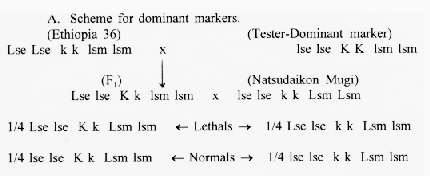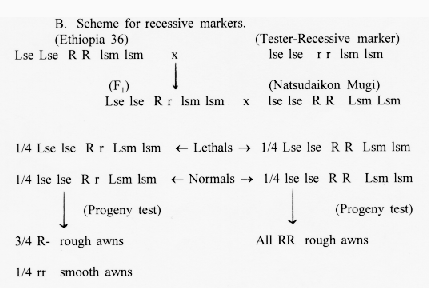

Weibe (1934) and Takahashi et al. (1971) reported that F1 seedlings derived from a cross of an Ethiopian strain, Ethiopia 36 (CI 2225, OUE 612) with Manchuria or a North Korean variety, Natsudaikon Mugi (OUK 735) always died at early stages of seedling development due to two complementary lethal genes, Lse and Lsm, carried by Ethiopia 36 and Natsudaikon Mugi, respectively. However, since no information is available on the chromosomal location and linkage analysis of these complementary genetic factors, the possibility that they are alleles cannot be ruled out.
A strategy to indirectly demonstrate that Lse and Lsm may be different loci is shown in Figure 1. In order to demonstrate that Lse is linked to a genetic marker, F1 plants derived from the cross between the variety carrying Lse and a tester carrying a genetic marker were crossed with the variety carrying Lsm. Based upon the complementation of Lse and Lsm, half the progeny is expected to be lethal, whereas the other half normal. Assuming the presence of a dominant marker such as hooded (K) and if Lse/lse and K/k genes segregate independently, a 1:1 ratio (hooded spike: normal spike) is expected among normal plants. However, more hooded spikes than normal spikes are expected if lse/lse and K/k genes are closely linked. If they are completely linked, all the spikes will be hooded. Assuming the presence of a recessive marker such as smooth awn (r), an additional progeny test is required to determine the genotype of each normal plant. If lse/lse and R/r genes segregate independently, all the progenies derived from one half of the normal plants are expected to have rough awns, whereas progenies derived from the other half are expected to segregate in a 3:1 ratio (rough awn:smooth awn). If lse/lse and R/r genes are closely linked, more segregating progenies (3:1 ratio of rough awn:smooth awn) than non-segregating progenies (rough awn only) are expected. If they are completely linked, all the progenies will segregate.
To determine that Lsm is linked to a dominant or recessive marker, F1 plants derived from the cross between the variety carrying Lsm and a tester carrying the genetic marker were crossed with the variety carrying lse. Subsequently, data analyses proceed in a similar manner as described above.
In summary, the aforementioned strategy is useful and valid to demonstrate that lse and Lsm are different loci. However, if both lse and Lsm are linked to the same series of genetic markers carried by one chromosome, it is difficult and time demanding to determine that they are alleles.
References:
Takahashi, R., J. Hayashi, and I. Moriya. 1971. Studies on lethal seedlings of barley by complementary genes. I. Mode of inheritance and geographical distribution of the lethal genes. Nogaku Kenkyu 53:197-204 (in Japanese).
Wiebe, G. A. 1934. Complementary factors in barley giving a lethal progeny. J. Hered. 25 :273-274.

